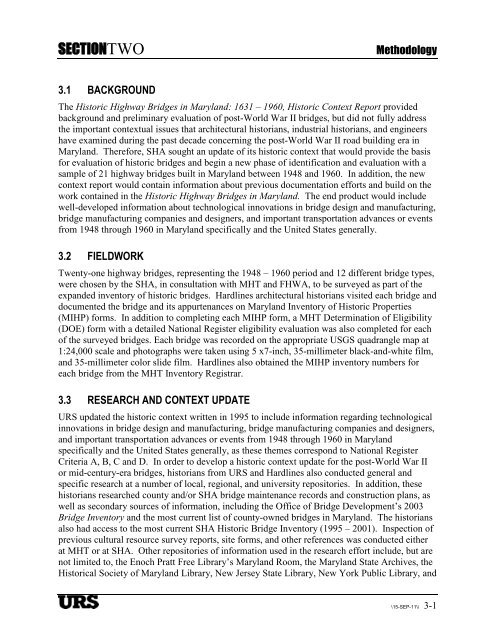historic context of maryland highway bridges built between 1948 ...
historic context of maryland highway bridges built between 1948 ...
historic context of maryland highway bridges built between 1948 ...
- No tags were found...
You also want an ePaper? Increase the reach of your titles
YUMPU automatically turns print PDFs into web optimized ePapers that Google loves.
3. Section 1 ONE Methodolog ySECTIONTWOMethodology3.1 BACKGROUNDThe Historic Highway Bridges in Maryland: 1631 – 1960, Historic Context Report providedbackground and preliminary evaluation <strong>of</strong> post-World War II <strong>bridges</strong>, but did not fully addressthe important <strong>context</strong>ual issues that architectural historians, industrial historians, and engineershave examined during the past decade concerning the post-World War II road building era inMaryland. Therefore, SHA sought an update <strong>of</strong> its <strong>historic</strong> <strong>context</strong> that would provide the basisfor evaluation <strong>of</strong> <strong>historic</strong> <strong>bridges</strong> and begin a new phase <strong>of</strong> identification and evaluation with asample <strong>of</strong> 21 <strong>highway</strong> <strong>bridges</strong> <strong>built</strong> in Maryland <strong>between</strong> <strong>1948</strong> and 1960. In addition, the new<strong>context</strong> report would contain information about previous documentation efforts and build on thework contained in the Historic Highway Bridges in Maryland. The end product would includewell-developed information about technological innovations in bridge design and manufacturing,bridge manufacturing companies and designers, and important transportation advances or eventsfrom <strong>1948</strong> through 1960 in Maryland specifically and the United States generally.3.2 FIELDWORKTwenty-one <strong>highway</strong> <strong>bridges</strong>, representing the <strong>1948</strong> – 1960 period and 12 different bridge types,were chosen by the SHA, in consultation with MHT and FHWA, to be surveyed as part <strong>of</strong> theexpanded inventory <strong>of</strong> <strong>historic</strong> <strong>bridges</strong>. Hardlines architectural historians visited each bridge anddocumented the bridge and its appurtenances on Maryland Inventory <strong>of</strong> Historic Properties(MIHP) forms. In addition to completing each MIHP form, a MHT Determination <strong>of</strong> Eligibility(DOE) form with a detailed National Register eligibility evaluation was also completed for each<strong>of</strong> the surveyed <strong>bridges</strong>. Each bridge was recorded on the appropriate USGS quadrangle map at1:24,000 scale and photographs were taken using 5 x7-inch, 35-millimeter black-and-white film,and 35-millimeter color slide film. Hardlines also obtained the MIHP inventory numbers foreach bridge from the MHT Inventory Registrar.3.3 RESEARCH AND CONTEXT UPDATEURS updated the <strong>historic</strong> <strong>context</strong> written in 1995 to include information regarding technologicalinnovations in bridge design and manufacturing, bridge manufacturing companies and designers,and important transportation advances or events from <strong>1948</strong> through 1960 in Marylandspecifically and the United States generally, as these themes correspond to National RegisterCriteria A, B, C and D. In order to develop a <strong>historic</strong> <strong>context</strong> update for the post-World War IIor mid-century-era <strong>bridges</strong>, historians from URS and Hardlines also conducted general andspecific research at a number <strong>of</strong> local, regional, and university repositories. In addition, thesehistorians researched county and/or SHA bridge maintenance records and construction plans, aswell as secondary sources <strong>of</strong> information, including the Office <strong>of</strong> Bridge Development‘s 2003Bridge Inventory and the most current list <strong>of</strong> county-owned <strong>bridges</strong> in Maryland. The historiansalso had access to the most current SHA Historic Bridge Inventory (1995 – 2001). Inspection <strong>of</strong>previous cultural resource survey reports, site forms, and other references was conducted eitherat MHT or at SHA. Other repositories <strong>of</strong> information used in the research effort include, but arenot limited to, the Enoch Pratt Free Library‘s Maryland Room, the Maryland State Archives, theHistorical Society <strong>of</strong> Maryland Library, New Jersey State Library, New York Public Library, and\15-SEP-11\\ 3-1
















